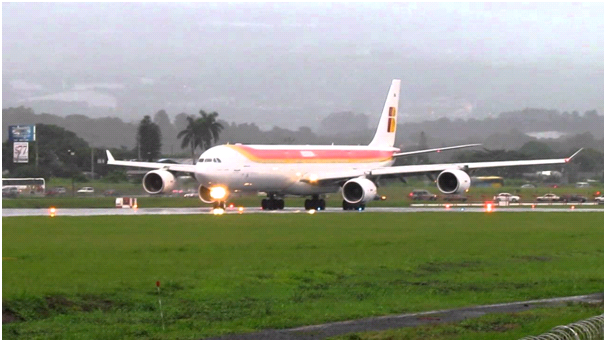Leeham News and Analysis
There's more to real news than a news release.
Pontifications: “Troubled” 787 is a thing of the past
LNC has been beset by technical issues since Aug. 17 that interferes with e-mail notification as well as links to Twitter, Facebook and Linkedin. We’re working on it with Wordpress.
Aug. 29, 2016, © Leeham Co.: Faulty engines dominated commercial aviation news last week.
First was ANA’s Boeing 787s were hit by issues with its Rolls-Royce engines. Corrosion was found on key engine parts. ANA cancelled flights to inspect and repair the engines.
Unfortunately, some media characterized the matter as the “latest” to hit the “troubled” 787. The London Telegraph is one example.
This characterization, of course, refers to the history of the 787 with its design and production challenges and later by the grounding from the lithium-ion battery fires.
Russian-Chinese wide-body: The aircraft
By Bjorn Fehrm
Subscription required.
Introduction
August29, 2016, ©. Leeham Co: We have now covered the capabilities of the joint venture partners for a Russian-Chinese wide-body and its possible market. Now we will look at what kind of aircraft such a cooperation can create, given technology and other constraints.
There have been bits and pieces leaked to media from Russia’s United Aircraft Corporation (UAC) and Commercial Aircraft Corporation of China (COMAC).
We will look at what has been said and combine that with our knowledge of existing and future technological capabilities of the parties to make predictions for what aircraft the project can produce.
Summary:
- The Russian-Chinese wide-bodywill be made to cover the “small wide-body”market.
- Initial size will be a 250-280 passenger wide-body
- The aircraft will be a twin with engines from either GE or Rolls-Royce.
- Range with 280 passengers will be 6,500nm.
Airbus Group 1H2016 results: Trouble in key programs
Updated with analyst reports.
By Bjorn Fehrm
27 July 2016, ©. Leeham Co: Airbus Group presented its first half year results today, posting strong results in the face of delivery troubles with the A320neo and A350; and more charges on the ailing A400M. It has been a troubled start to 2016 with deliveries in key programs (A320, A350, A400M, Super Puma H225) being far behind targets. In total only the space segment is going well in Airbus Group at the moment.
The key commercial aircraft segment is still enjoying a vast backlog (6,700 aircraft) and sales which point to a book to bill of one for the year. But deliveries are not going well. Twenty A320neo “gliders” are just now getting their first engines and the A350 delivery problems are dragging on.
On top of that, the A400M program has hit new problems in the engine area where the propeller gearbox needs a redesign. An interim fix is needed to keep customers flying.
Airbus helicopter side has also hit trouble. The large Super Puma H225 helicopter suffered a fatal off-shore area crash in April and is still grounded as the investigation to what broke in the helicopter is taking time.
The financial results for the Airbus Group for the first half of 2016 (1H 2015) were revenue €28.8b (€28.9b) with net profit €1.8b (€1.5b). These figures includes €1.9b in write offs (A400m €1b, A350 €0.4, Currency €0.5b) and €2.1b in capital gain one offs (Launchers JV valuation €1.1b, Dassault shares €0.9b, Divestitures €0.1b). This means that one time effects kept the result up for 1H 2016 but these will not be there the next quarters should the troubles continue. Airbus Group maintains 2016 guidance for Revenue, EBIT and Free Cash Flow.
Here the details of the Airbus Group divisions results for first half 2016:
Pontifications: Boeing is back
July 4, 2016, © Leeham Co.: It’s looking like all the pain and agony of the 787 development is behind Boeing. (Except for the deferred production costs, of course.)
Boeing is back into airplane development mode.
To be sure, only one of these is a new airplane. The others are derivatives. But at least Boeing seems to be on the move after slowing the train (to mix the metaphors) considerably following the 787 debacle.
Bjorn’s Corner: Engine architectures
 4 March 2016, ©. Leeham Co: There is a saying, “There’s more than one way to skin a cat.” The same goes for making successful Turbofans to commercial aircraft.
4 March 2016, ©. Leeham Co: There is a saying, “There’s more than one way to skin a cat.” The same goes for making successful Turbofans to commercial aircraft.
At the recent Pacific Northwest Aerospace Alliance 2016 sub-supplier conference in Seattle, GE, Rolls-Royce and Pratt & Whitney all talked about their latest engine projects and the technology development that was critical to their success.
The engines they talked about, the GE9x, Rolls-Royce Advance and Pratt & Whitney’s Geared Turbofan, can all be characterised as the best of breed for their intended use but they could not be more different in how their level of excellence is achieved.
It made for interesting listening. Here’s the gist of what was told.
ISTAT Day 1: Used 777 values depend on engines, leases
Feb. 29, 2016 (c) Leeham Co.: The Boeing 777-200ER is not worth $7.7m or even $10m,  but $37m to $47m, according to four appraisers who appeared today at the ISTAT AGM.
but $37m to $47m, according to four appraisers who appeared today at the ISTAT AGM.
- We’re at the 2016 ISTAT AGM in Phoenix and will be reporting today and tomorrow on presentations and news from the sidelines.
Doug Kelly of the consulting/appraisal firm Avitas notes that the Rolls-Royce Trent-powered 777s are, indeed, the least desirable airplanes. GE or PW-powered airplanes commands a $7m premium, he said.
AerCap is selling 777-200ERs with leases attached for more than $50m, Kelly said.
Bjorn’s Corner: Efficient systems, Part 2
12 February 2016, ©. Leeham Co: Last week we looked at what could be done to the aircraft’s systems to increase the aircraft’s efficiency. But it does not stop with systems which can improve the aircrafts internal efficiency. Modern avionics and flight procedures can improve the efficiency of an airliner’s flight operation.
Ever since the Second World War, the navigation of civil airliners has been done by flying straight leg routes with the help of special ground-based radio beacons. The most elementary of these is the Non-Directional Beacon, NDB. It requires the pilot to read bearings to the beacon and is difficult to use.
A directional beacon called VOR, that went operational after WW2, changed the way that airliners could navigate (over large un-inhabited areas like the Atlantic or the Oceans, different low precision wide area navigation systems were used like LORAN). While the VOR was a big step forward, it still required navigation in straight leg routes between VORs, and this was not 100% efficient.
The development of powerful navigation computers (FMS) and the use of GPS is now changing this.
Analysis: Sukhoi’s regional jet SSJ100, Part 2
By Bjorn Fehrm
Subscription required
Introduction
21 January 2016, ©. Leeham Co: The first part of our analysis, published Monday, looked at Russia’s first effort to design and aircraft to penetrate the Western airplane market, Sukhoi Superjet (SSJ100). We concluded that the SSJ100 regional airliner was a good effort.
The aircraft was essentially a Russian airframe with Franco-Russian engines, Western systems and Western avionics. For aircraft that are delivered to Western airlines, it also has an Italian-designed/produced interior.
The aircraft has been in successful deployment with Interjet of Mexico and has now been ordered by CityJet of Dublin. After having looked at base characteristics of the aircraft/engine and also analysed the fuel consumption, we now continue with developing the Cash and Direct Operating Costs of the SSJ100. We compare it with the market leader in the 100 seats regional market, Embraer’s E190.
Summary:
- The SSJ100 is competitive on fuel costs compared to the E190.
- Maintenance costs for SSJ100 is still hard to predict as there is still too limited operational experience.
- Capital costs are lower for the SSJ100. This means that Direct Operating Costs, DOC, are attractive for the SSJ100.




